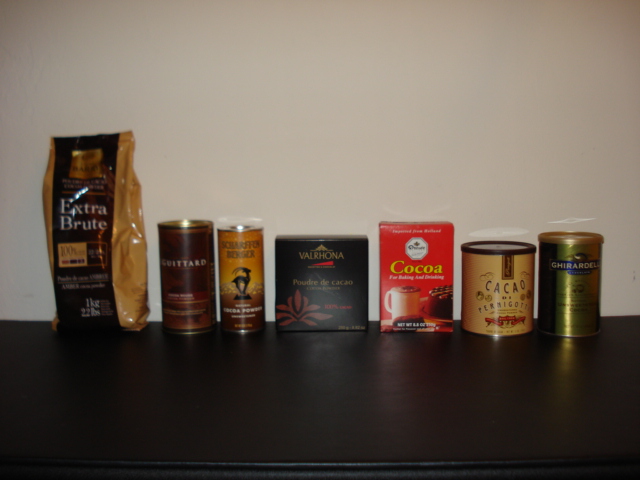The Contenders
Which brands have earned the right to compete for the title of Ultimate Cocoa Powder? Let’s have a look!
From left to right:
- Callebaut – Though headquartered in Switzerland, Barry-Callebaut is a Belgian chocolate company. Cacao Barry is from the French division of Barry Callebaut, but still considered Belgian chocolate. Cacao Barry Extra Brute cocoa powder has a 22%-24% fat content and is Dutch processed.
- Guittard – Founded by French chocolatier Etienne Guittard in San Francisco, California in the 1800s. Because of the European roots, Guittard chocolate stands several notches above conventional American chocolate. Cocoa Rouge, or red-toned cocoa powder. Dutch processed, with 22%-24% fat content.
- Scharffen-Berger – Although Scharffen-Berger chocolate is an American chocolate company, it sets itself apart by using the European method of roasting the cocoa beans “low and slow” for optimal flavor. Scharffen-Berger offers natural cocoa powder, not Dutch processed.
- Valrhona – Originated in 1922 in the Rhone Valley of France. Valrhona has elevated chocolate making to an art form, and even have extensive instructional information on how to degust their chocolates. Valrhona cocoa powder is Dutch processed and know for its deep red coloring. It is 21% fat.
- Droste – Dutch cocoa powder, also Dutch processed. Droste is another chocolate company with its origins in the 1800s.
- Pernigotti – Aside from the fact that they are Italian, I couldn’t dig up too much info on them. Their cocoa powder, however, has the unique characteristic of having ground vanilla bean in it. It is Dutch processed cocoa powder with 20%-22% fat content.
- Ghirardelli – Another American cocoa powder. Ghirardelli prides itself on being one of the few American manufacturers that makes their chocolate from start to finish. Meaning, they pick and roast their own cocoa beans, and see them through to the finished product. Ghirardelli offers natural cocoa powder.
For those of you who might be wondering, dutch processed cocoa powder is cocoa powder that has been treated with an alkali to neutralize its acidity. Because of their lack of acidity, they do not react with baking soda, and should be used in recipes that contain baking powder. Due to the decreased acidity, they tend to be more mellow and dark than their natural counterparts. Natural cocoa powders, on the other hand, are more acidic. Therefore, they react to baking soda as leavening for baking. Since the recipe that I intend to use calls for both baking soda AND baking powder, I have both areas covered.

